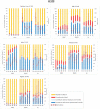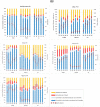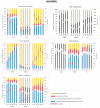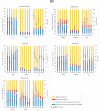Modern contraceptive availability and stockouts: a multi-country analysis of trends in supply and consumption
- PMID: 33454786
- PMCID: PMC8058948
- DOI: 10.1093/heapol/czaa197
Modern contraceptive availability and stockouts: a multi-country analysis of trends in supply and consumption
Abstract
Approximately 214 million women of reproductive age lack adequate access to contraception for their family planning needs, yet patterns of contraceptive availability have seldom been examined. With growing demand for contraceptives in some areas, low contraceptive method availability and stockouts are thought to be major drivers of unmet need among women of reproductive age, though evidence for this is limited. In this research, we examined trends in stockouts, method availability and consumption of specific contraceptive methods in urban areas of four sub-Saharan African countries (Burkina Faso, Democratic Republic of Congo, Kenya and Nigeria) and India. We used representative survey data from the Performance Monitoring for Action Agile Project that were collected in quarterly intervals at service delivery points (SDP) stratified by sector (public vs private), with all countries having five to six quarters of surveys between 2017 and 2019. Among SDPs that offer family planning, we calculated the percentage offering at least one type of modern contraceptive method (MCM) for each country and quarter, and by sector. We examined trends in the percentage of SDPs with stockouts and which currently offer condoms, emergency contraception, oral pills, injectables, intrauterine devices and implants. We also examined trends of client visits for specific methods and the resulting estimated protection from pregnancy by quarter and country. Across all countries, the vast majority of SDPs had at least one type of MCM in-stock during the study period. We find that the frequency of stockouts varies by method and sector and is much more dynamic than previously thought. While the availability and distribution of long-acting reversible contraceptives (LARCs) were limited compared to other methods across countries, LARCs nonetheless consistently accounted for a larger portion of couple years of protection. We discuss findings that show the importance of engaging the private sector towards achieving global and national family planning goals.
Keywords: Family planning; contraception; health services; public/private; reproductive health; surveillance; survey methods.
© The Author(s) 2021. Published by Oxford University Press in association with The London School of Hygiene and Tropical Medicine.
Figures






Similar articles
-
Trends in and Correlates of Short-Acting Contraceptive Stock-Outs: Multicountry Analysis of Performance Monitoring for Action Agile Platform Data.Glob Health Sci Pract. 2024 Jun 27;12(3):e2300411. doi: 10.9745/GHSP-D-23-00411. Print 2024 Jun 27. Glob Health Sci Pract. 2024. PMID: 38744488 Free PMC article.
-
Trends in contraceptive prevalence rates in sub-Saharan Africa since the 2012 London Summit on Family Planning: results from repeated cross-sectional surveys.Lancet Glob Health. 2019 Jul;7(7):e904-e911. doi: 10.1016/S2214-109X(19)30200-1. Epub 2019 May 17. Lancet Glob Health. 2019. PMID: 31109881 Free PMC article.
-
Leveraging long acting reversible contraceptives to achieve FP2020 commitments in sub-Saharan Africa: The potential of implants.PLoS One. 2018 Apr 9;13(4):e0195228. doi: 10.1371/journal.pone.0195228. eCollection 2018. PLoS One. 2018. PMID: 29630607 Free PMC article.
-
Towards achieving the family planning targets in the African region: a rapid review of task sharing policies.Reprod Health. 2021 Jan 23;18(1):22. doi: 10.1186/s12978-020-01038-y. Reprod Health. 2021. PMID: 33485339 Free PMC article. Review.
-
Canadian Contraception Consensus (Part 1 of 4).J Obstet Gynaecol Can. 2015 Oct;37(10):936-42. doi: 10.1016/s1701-2163(16)30033-0. J Obstet Gynaecol Can. 2015. PMID: 26606712 English, French.
Cited by
-
Trends in and Correlates of Short-Acting Contraceptive Stock-Outs: Multicountry Analysis of Performance Monitoring for Action Agile Platform Data.Glob Health Sci Pract. 2024 Jun 27;12(3):e2300411. doi: 10.9745/GHSP-D-23-00411. Print 2024 Jun 27. Glob Health Sci Pract. 2024. PMID: 38744488 Free PMC article.
-
Availability of emergency contraception in large Brazilian municipalities: a guaranteed right?Front Pharmacol. 2023 Nov 27;14:1023464. doi: 10.3389/fphar.2023.1023464. eCollection 2023. Front Pharmacol. 2023. PMID: 38089053 Free PMC article.
-
Ensuring People Living with HIV Inform the Future of HIV Treatment in Low- and Middle-Income Countries: A Scoping Review and Recommendations for a Community-Led Research Agenda.AIDS Behav. 2024 Oct;28(10):3437-3448. doi: 10.1007/s10461-024-04442-8. Epub 2024 Jul 11. AIDS Behav. 2024. PMID: 38992225 Free PMC article.
-
Family planning service disruptions in the first two years of the COVID-19 pandemic: Evidence from health facilities in seven low- and middle-income countries.PLOS Glob Public Health. 2024 Jan 5;4(1):e0002435. doi: 10.1371/journal.pgph.0002435. eCollection 2024. PLOS Glob Public Health. 2024. PMID: 38180911 Free PMC article.
-
Barriers to modern contraceptive use by female workers in Indonesia's urban areas.Korean J Fam Med. 2025 Jul;46(4):240-246. doi: 10.4082/kjfm.24.0005. Epub 2024 Jun 18. Korean J Fam Med. 2025. PMID: 38886147 Free PMC article.
References
-
- Ahmed S, Li Q, Liu L. et al.. 2012.Maternal deaths averted by contraceptive use: an analysis of 172 countries. The Lancet 380: 111–25. - PubMed
MeSH terms
LinkOut - more resources
Full Text Sources
Other Literature Sources
Medical

